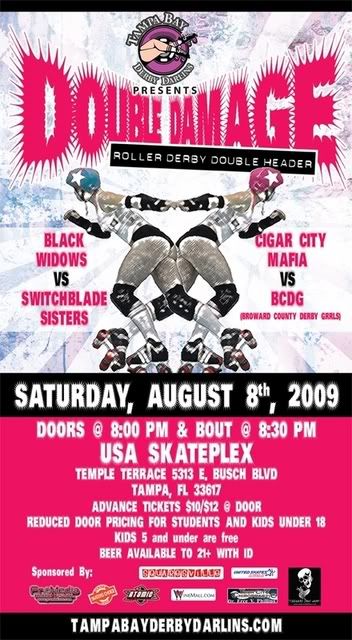
Last night was fun!
Our friend, Cherisse, came over and I drove to the Roller Derby. We got there right on time and the parking lot was already full -- we parked at K-mart across the street. Alyssa met us there too. The Skateplex is much bigger than United Skates (where I had my party), but not as nice looking. They did have some video games and ski ball, but no photo machine. The rink was a regular skating rink (not the kind that's banked or angled on the sides).
We had a lot of fun watching the bouts. The teams we picked to win kicked butt! It was a great night.
Here's how it works:
We had a lot of fun watching the bouts. The teams we picked to win kicked butt! It was a great night.
Here's how it works:
Roller derby takes place on a circuit track. It is somewhat unusual among competitive sports in that offense and defense are played simultaneously. The two teams playing send five players each onto the track — three blockers (defense), one pivot (last line of defense) and one jammer (scorer). Helmet covers are used to display the players' positions: a striped cover is used for pivots, a cover with two stars is used for jammers, and no cover is used for blockers.
Pivots and blockers from both teams start the game by forming a single pack. In a pack, all players face counterclockwise. The pivots line up next to each other, followed by a layer of four blockers, followed by a layer of two blockers. The two jammers, who are not considered to be part of the pack, are positioned 20 feet behind the pack. At this point, no differentiation need be made between the two teams; as long as the pack formation is as described above, it does not matter if the team members are interspersed randomly in the pack.
The referee signals the start of jam formation by blowing a whistle. During jam formation, the entire pack moves counterclockwise, during which time players can change position. All pivots/blockers must remain in the pack (i.e., no more than 20 feet in front of or behind the largest group containing blockers from both teams ). Jammers remain stationary during jam formation. When the last person in the pack has passed where the front of the pack was initially lined up, the referee blows the whistle twice, signaling the jammers to take off, and play begins in earnest with a jam.
A jam is a 2-minute countdown period during which both teams attempt to score points. Points can only be scored by the jammers, who, moving counter-clockwise, attempt to pass the pack and lap around as many times as possible. After passing the pack the first time, jammers earn one point each time they legally pass an opposing blocker/pivot. During a jam, all pivots/blockers must remain in the pack. Pivot/blockers attempt to assist their jammer through and out of the pack while simultaneously stopping the opposing jammer from exiting the pack. If a pivot/blocker falls or otherwise becomes separated from the pack, she is out of play (i.e., cannot block or assist the jammers) until she catches up to the pack.
The first jammer to pass all pivots and blockers once the jam begins wins the status of lead jammer for the remainder of the jam. The lead jammer can decide to end the jam at any time before the 2 minutes are up. She does this by placing her hands on her hips repeatedly, which signals the referee to officially call off the jam.
After a lead jammer has been established, both jammers have the option of passing their positions to their teams' respective pivots (passing the star). This is done by removing the 2-star helmet cover and handing it to the pivot. The pivot then becomes the jammer, and the jammer becomes the pivot for the remainder of the jam. If the original jammer was the lead jammer, the position of lead jammer is not passed on; the position is forfeited for the remainder of the jam.
To impede the progress of the opposing team's jammer, players may block using body parts above the mid-thigh, excluding forearms, hands, and head. Elbows may not be used in blocking, and cannot be swung at other players or used to hook an opponent's or teammate's arm.
Each game consists of two 30-minute or three 20-minute periods. At the end of each jam, players re-form the pack and continue play.
Penalties are given to skaters who block illegally, fight or behave in an unsporting manner, or otherwise break the rules. Possible penalties include sending players to a penalty box (during which time opposing jammers score for opposing skaters in the penalty box when they score their first point in each pass) and expulsion of players. A skater goes to the penalty box for 1 minute immediately upon incurring a major penalty, or after accumulating 4 minor penalties.
Click here for Roller Derby info and history.
No comments:
Post a Comment